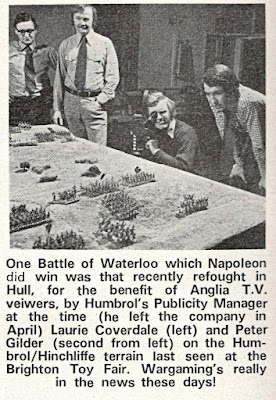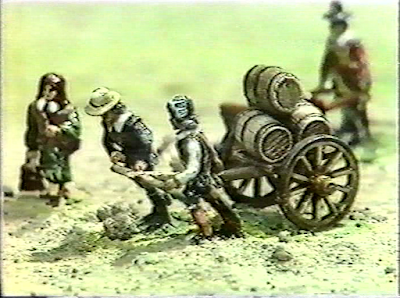The Hull Group admiring the Waterloo terrain prior to a photo shoot with Peter Gilder, Laurie Coverdale of Humbrol Paints, Rob Baker and John Tilson looking at one of Gilder's representations of the Battle of Waterloo, of which he made several.
John Tilson has been wargaming a long time but had been interested in military history long before that, he started as many early wargamers did as a member of the British Model Soldier Society [BMSS] which contained most of the UK's pioneering wargamers.
John who lived in Hull in the early 1960's had become friends with Bill Lamming whom he had met at the BMSS meeting at York. At that time Bill Lamming was a soldier collector who also made 54mm figures.
He was introduced to Peter Gilder by Bill Lamming. Gilder had just moved to Hull and was living in a flat above a fish shop. He was working as a salesman for a company supplying stainless steel equipment to fish fryers. John knew of Peter Gilder via the Wargamers Newsletter where Donald Featherstone had sang Gilder's praises for his figure painting and terrain making.
In true Gilderesque style Gilder managed to interest Bill Lamming in creating smaller scale figures and amongst his first was an early French hussar in mirliton. Possibly this was the start of Lamming Miniatures which grew quickly through the 1970's and early 1980's.
Because Peter Gilder knew of John's interest in wargaming as well as collecting Briton's he invited him to a game in his flat above the chippy, and the rest was history as they say.They fought a couple of small campaigns using Peter's figures but as John said, 'did anyone ever win a game against Gilder?'
Gilder began to cast his own figures whilst becoming a member of the North Hull Wargames Club where he met John Braithwaite who later founded Garrison Miniatures. The pair became very close friends and sparked off each other.
Gilder created his first Waterloo terrain and staged the inaugural game in Willerby near Hull. This was the game he took to the original Waterloo Festival arranged by Donald Featherstone in London.
Whilst at the North Hull Club Gilder staged his second attempt of his famous Waterloo wargame using an improved wargames terrain and more figures. He also staged Borodino and Dresden at the club. It was clear Peter Gilder was learning as he soon after moved out of Hull and began working with Frank Hinchliffe to produce new ranges of 25mm figures.
During the time Gilder was in Hull he showed John how to improve is painting and how replace any bayonets and swords with flattened pins, a trademark Gilder touch. He also showed John how base and make better quality buildings. In order to speed up his unit production Peter Gilder would either leave bare or undercoat the underside off the cavalry and only paint what as visible, again it was a trademark Gilder trait for his early painted figures.
Gilder also introduced company bases, moving away from the original single figure bases then in use. Initially the figures were affixed with double-sided tape before Gilder took to permanently fixing the figures to terrained bases and introduced unit causality sheets.
John described Peter Gilder as a generous and knowledgeable wargamer and modeler always keen to help.










